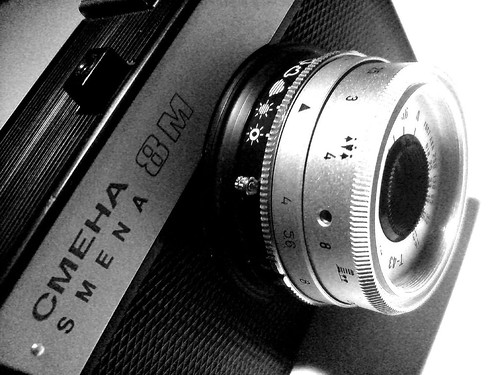 I'm starting to enjoy collecting vintage cameras from the former Soviet Union. My newest rare find was a special version of the FED-5B rangefinder camera produced in limited quantities to commemorate the 1980 Olympic Summer Games in Moscow.
I'm starting to enjoy collecting vintage cameras from the former Soviet Union. My newest rare find was a special version of the FED-5B rangefinder camera produced in limited quantities to commemorate the 1980 Olympic Summer Games in Moscow.Back in 1980, the 22nd Modern Olympic Summer Games were held in Moscow during the height of the Cold War. To promote the glorious event, all camera manufacturers issued one or more commemorative models of their 1979 or 1980 cameras. This "compliancy" was so uniformed and planned at that time, it seemed to indicate that they were commissioned by the Soviet government.
Affectionately nicknamed the "Moscow '80 variants" by camera enthusiasts, they're worth more than the standard model and valued substantially higher in terms of its "Soviet memorabilianess".



From 1955 onwards, the factory made a huge volume of cameras that resemble the Leica rather closely (and are often altered, given "Leica" markings, and sometimes even sold as Leicas). However, the design was much cruder.

There were three versions of the FED-5: the original FED-5 had an exposure meter, the FED-5B was a version without meter, and the later FED-5C had reflected framelines showing field of view of 50mm lens and an exposure meter.

 Sadly, the production of FED rangefinder cameras ended in the mid 1990s. In terms of looks, this camera definitely stands apart from the throng of other Russian deadstock. And with it's Moscow 80's logo, it's definitely a gold medal winner in my book.
Sadly, the production of FED rangefinder cameras ended in the mid 1990s. In terms of looks, this camera definitely stands apart from the throng of other Russian deadstock. And with it's Moscow 80's logo, it's definitely a gold medal winner in my book.SPECIFICATIONS:
Film Type: all standard 35mm
Lens: Industrar 61 1:2.8 f=55mm
Focal Range: .75mm to ∞
Shutter Speeds: B, 1, 1/2, 1/4, 1/8, 1/15, 1/30, 1/60, 1/125, 1/250, 1/500
Aperture Settings: f/2.8, f/4, f/5.6, f/8, f/11, f/16
Flash Connection: standard hot-shoe, sync at 1/30
[see lo-fi pics taken by FED-5B]
Offer Price: B$225































